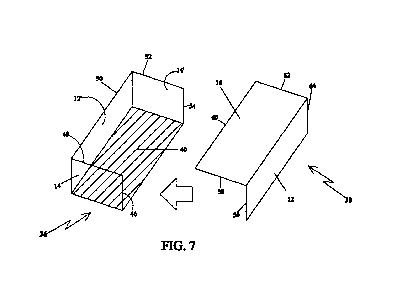Some of the information on this Web page has been provided by external sources. The Government of Canada is not responsible for the accuracy, reliability or currency of the information supplied by external sources. Users wishing to rely upon this information should consult directly with the source of the information. Content provided by external sources is not subject to official languages, privacy and accessibility requirements.
Any discrepancies in the text and image of the Claims and Abstract are due to differing posting times. Text of the Claims and Abstract are posted:
| (12) Patent Application: | (11) CA 2876836 |
|---|---|
| (54) English Title: | A PRODUCT FOR WASTE ELECTRICAL AND ELECTRONIC EQUIPMENT RE-UTILIZATION AND PROCESS THEREOF |
| (54) French Title: | PRODUIT POUR UNE REUTILISATION DE DECHET D'EQUIPEMENTS ELECTRIQUE ET ELECTRONIQUE ET PROCEDE ASSOCIE |
| Status: | Deemed Abandoned and Beyond the Period of Reinstatement - Pending Response to Notice of Disregarded Communication |
| (51) International Patent Classification (IPC): |
|
|---|---|
| (72) Inventors : |
|
| (73) Owners : |
|
| (71) Applicants : |
|
| (74) Agent: | FOGLER, RUBINOFF LLP |
| (74) Associate agent: | |
| (45) Issued: | |
| (86) PCT Filing Date: | 2013-04-12 |
| (87) Open to Public Inspection: | 2013-12-19 |
| Availability of licence: | N/A |
| Dedicated to the Public: | N/A |
| (25) Language of filing: | English |
| Patent Cooperation Treaty (PCT): | Yes |
|---|---|
| (86) PCT Filing Number: | PCT/IN2013/000244 |
| (87) International Publication Number: | WO 2013186787 |
| (85) National Entry: | 2014-12-15 |
| (30) Application Priority Data: | ||||||
|---|---|---|---|---|---|---|
|
A Waste Electrical and Electronic Equipment (WEEE) brick adapted to treat a bulk WEEE material for sustainable environmental reutilization is disclosed. The brick comprises a first part and a second part such that the first part is sequentially filled with a binder/filler material followed by filling with a WEEE material. The second part is securely coupled to the first part to form the WEEE brick. A process for preparation of Waste Electrical and Electronic Equipment (WEEE) brick is also disclosed.
La présente invention porte sur une brique de déchet d'équipements électrique et électronique (WEEE) conçue pour traiter un matériau WEEE encombrant pour une réutilisation environnementale durable. La brique comprend une première partie et une seconde partie de telle sorte que la première partie est successivement remplie avec un matériau d'apport/liant suivi par le remplissage avec un matériau WEEE. La seconde partie est couplée de manière sûre à la première partie pour former la brique de WEEE. Un procédé pour la préparation d'une brique de déchet d'équipements électrique et électronique (WEEE) est également présenté.
Note: Claims are shown in the official language in which they were submitted.
Note: Descriptions are shown in the official language in which they were submitted.

2024-08-01:As part of the Next Generation Patents (NGP) transition, the Canadian Patents Database (CPD) now contains a more detailed Event History, which replicates the Event Log of our new back-office solution.
Please note that "Inactive:" events refers to events no longer in use in our new back-office solution.
For a clearer understanding of the status of the application/patent presented on this page, the site Disclaimer , as well as the definitions for Patent , Event History , Maintenance Fee and Payment History should be consulted.
| Description | Date |
|---|---|
| Inactive: First IPC assigned | 2023-07-05 |
| Inactive: IPC assigned | 2023-07-05 |
| Inactive: IPC assigned | 2023-07-05 |
| Inactive: IPC expired | 2022-01-01 |
| Inactive: IPC removed | 2021-12-31 |
| Inactive: COVID 19 - Deadline extended | 2020-03-29 |
| Application Not Reinstated by Deadline | 2019-04-12 |
| Time Limit for Reversal Expired | 2019-04-12 |
| Deemed Abandoned - Failure to Respond to Maintenance Fee Notice | 2018-04-12 |
| Inactive: Abandon-RFE+Late fee unpaid-Correspondence sent | 2018-04-12 |
| Letter Sent | 2016-08-05 |
| Reinstatement Requirements Deemed Compliant for All Abandonment Reasons | 2016-08-04 |
| Inactive: Office letter | 2016-06-20 |
| Maintenance Request Received | 2016-05-20 |
| Deemed Abandoned - Failure to Respond to Maintenance Fee Notice | 2016-04-12 |
| Inactive: Cover page published | 2015-02-11 |
| Application Received - PCT | 2015-01-12 |
| Inactive: First IPC assigned | 2015-01-12 |
| Inactive: Notice - National entry - No RFE | 2015-01-12 |
| Inactive: IPC assigned | 2015-01-12 |
| Inactive: IPC assigned | 2015-01-12 |
| National Entry Requirements Determined Compliant | 2014-12-15 |
| Small Entity Declaration Determined Compliant | 2014-12-15 |
| Application Published (Open to Public Inspection) | 2013-12-19 |
| Abandonment Date | Reason | Reinstatement Date |
|---|---|---|
| 2018-04-12 | ||
| 2016-04-12 |
The last payment was received on 2016-08-04
Note : If the full payment has not been received on or before the date indicated, a further fee may be required which may be one of the following
Please refer to the CIPO Patent Fees web page to see all current fee amounts.
| Fee Type | Anniversary Year | Due Date | Paid Date |
|---|---|---|---|
| Basic national fee - small | 2014-12-15 | ||
| MF (application, 2nd anniv.) - small | 02 | 2015-04-13 | 2015-04-09 |
| 2016-05-20 | |||
| MF (application, 4th anniv.) - small | 04 | 2017-04-12 | 2016-08-04 |
| MF (application, 3rd anniv.) - small | 03 | 2016-04-12 | 2016-08-04 |
| Reinstatement | 2016-08-04 |
Note: Records showing the ownership history in alphabetical order.
| Current Owners on Record |
|---|
| RAHUL NAGPAUL |
| Past Owners on Record |
|---|
| None |